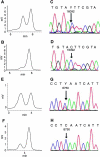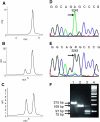Mitochondrial DNA mutations in renal cell carcinomas revealed no general impact on energy metabolism
- PMID: 16404428
- PMCID: PMC2361126
- DOI: 10.1038/sj.bjc.6602929
Mitochondrial DNA mutations in renal cell carcinomas revealed no general impact on energy metabolism
Abstract
Previously, renal cell carcinoma tissues were reported to display a marked reduction of components of the respiratory chain. To elucidate a possible relationship between tumourigenesis and alterations of oxidative phosphorylation, we screened for mutations of the mitochondrial DNA (mtDNA) in renal carcinoma tissues and patient-matched normal kidney cortex. Seven of the 15 samples investigated revealed at least one somatic heteroplasmic mutation as determined by denaturating HPLC analysis (DHPLC). No homoplasmic somatic mutations were observed. Actually, half of the mutations presented a level of heteroplasmy below 25%, which could be easily overlooked by automated sequence analysis. The somatic mutations included four known D-loop mutations, four so far unreported mutations in ribosomal genes, one synonymous change in the ND4 gene and four nonsynonymous base changes in the ND2, COI, ND5 and ND4L genes. One renal cell carcinoma tissue showed a somatic A3243G mutation, which is a known frequent cause of MELAS syndrome (mitochondrial encephalomyopathy, lactic acidosis, stroke-like episode) and specific compensatory alterations of enzyme activities of the respiratory chain in the tumour tissue. No difference between histopathology and clinical progression compared to the other tumour tissues was observed. In conclusion, the low abundance as well as the frequently observed low level of heteroplasmy of somatic mtDNA mutations indicates that the decreased aerobic energy capacity in tumour tissue seems to be mediated by a general nuclear regulated mechanism.
Figures



Similar articles
-
Mutations in the ND5 subunit of complex I of the mitochondrial DNA are a frequent cause of oxidative phosphorylation disease.J Med Genet. 2007 Apr;44(4):e74. doi: 10.1136/jmg.2006.045716. J Med Genet. 2007. PMID: 17400793 Free PMC article.
-
Mitochondrial DNA mutations in pancreatic cancer.Int J Gastrointest Cancer. 2006;37(2-3):57-64. doi: 10.1007/s12029-007-0008-2. Int J Gastrointest Cancer. 2006. PMID: 17827523
-
Somatic mitochondrial DNA mutations in human chromophobe renal cell carcinomas.Genes Chromosomes Cancer. 2002 Nov;35(3):256-60. doi: 10.1002/gcc.10118. Genes Chromosomes Cancer. 2002. PMID: 12353267
-
Von Hippel-Lindau disease and sporadic renal cell carcinoma.Cancer Surv. 1995;25:219-32. Cancer Surv. 1995. PMID: 8718521 Review.
-
[Prevention of renal carcinoma: the nutri-genetic approach].J Soc Biol. 2000;194(1):29-38. J Soc Biol. 2000. PMID: 11107547 Review. French.
Cited by
-
Regulation of metastasis; mitochondrial DNA mutations have appeared on stage.J Bioenerg Biomembr. 2012 Dec;44(6):639-44. doi: 10.1007/s10863-012-9468-6. J Bioenerg Biomembr. 2012. PMID: 22895836 Review.
-
Mitochondrial DNA instability and metabolic shift in human cancers.Int J Mol Sci. 2009 Feb;10(2):674-701. doi: 10.3390/ijms10020674. Epub 2009 Feb 23. Int J Mol Sci. 2009. PMID: 19333428 Free PMC article. Review.
-
Aspartate β-hydroxylase disrupts mitochondrial DNA stability and function in hepatocellular carcinoma.Oncogenesis. 2017 Jul 17;6(7):e362. doi: 10.1038/oncsis.2017.64. Oncogenesis. 2017. PMID: 28714949 Free PMC article.
-
Heterologous Inferential Analysis (HIA) and Other Emerging Concepts: In Understanding Mitochondrial Variation In Pathogenesis: There is no More Low-Hanging Fruit.Methods Mol Biol. 2021;2277:203-245. doi: 10.1007/978-1-0716-1270-5_14. Methods Mol Biol. 2021. PMID: 34080154
-
Hypermethylation of mitochondrial DNA facilitates bone metastasis of renal cell carcinoma.J Cancer. 2022 Jan 1;13(1):304-312. doi: 10.7150/jca.62278. eCollection 2022. J Cancer. 2022. PMID: 34976191 Free PMC article.
References
-
- Berger A, Mayr JA, Meierhofer D, Foetschl U, Bittner R, Budka H, Grethen C, Huemer M, Kofler B, Sperl W (2003) Severe depletion of mitochondrial DNA in spinal muscular atrophy. Acta Neuropathol 105: 245–251 - PubMed
-
- Brauch H, Weirich G, Brieger J, Glavac D, Rodl H, Eichinger M, Feurer M, Weidt E, Puranakanitstha C, Neuhaus C, Pomer S, Brenner W, Schirmacher P, Storkel S, Rotter M, Masera A, Gugeler N, Decker HJ (2000) VHL alterations in human clear cell renal cell carcinoma: association with advanced tumor stage and a novel hot spot mutation. Cancer Res 60: 1942–1948 - PubMed
-
- Coller HA, Khrapko K, Bodyak ND, Nekhaeva E, Herrero-Jimenez P, Thilly WG (2001) High frequency of homoplasmic mitochondrial DNA mutations in human tumors can be explained without selection. Nat Genet 28: 147–150 - PubMed
Publication types
MeSH terms
Substances
LinkOut - more resources
Full Text Sources
Medical

